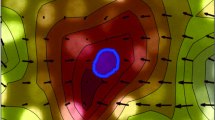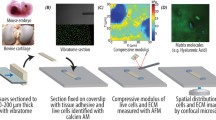Summary
In this study we assessed the behavior of fibroblasts during contraction of collagen lattices. We applied a new technique for three-dimensional time-lapse studies of movements of living cells using phase-contrast laser scanning microscopy. Five anchored and five floating collagen lattices were studied regarding the activity of cells during a 7-h period of active contraction. Three-dimensional reconstructions of the fibroblasts and their extensions were made from datasets of 16–26 “optical sections” 5 μm apart recorded hourly during the period of measurements. The distance between fibroblast nuclei in the floating lattices decreased by a mean of 6.8 μm, but remained constant in the anchored group. Only minor variations were found in the angle between a line connecting any two nuclei and the tangent of the lattice margin. The lengths of the cellular extensions continuously changed by shortening and extending, and an increasing number of intercellular contacts were established with time. The angle between the extensions and the periphery of the lattice varied continually, and no distinct pattern of arrangement of the extensions was seen. In conclusion, we have shown in living cells in vitro that fibroblasts do not appear to move around within lattices during contraction but rather send out and withdraw cellular extensions continuously. This speaks against cellular locomotion or movement as a main feature of contraction. Time-lapse scanning laser microscopy has also been shown to be a suitable method to study cellular behavior quantitatively in three dimensions during lattice contraction.
Similar content being viewed by others
References
Allen, T. D.; Schor, S. L. The contraction of collagen matrices by dermal fibroblasts. J. Ultrastruct. Res. 83:205–219; 1983.
Andujar, M. B.; Melin, M.; Guerret, S., et al. Cell migration influences collagen gel contraction. J. Submicrosc. Cytol. Pathol. 24:145–154; 1992.
Assoian, R. K.; Sporn, M. B. Type β transforming growth factor in human platelets: release during platelet degranulation and action on vascular smooth muscle cells. J. Cell Biol. 102:1217–1223; 1986.
Bell, E.; Ivarsson, B.; Merrill, C. Production of a tissue-like structure by contraction of collagen lattices by human fibroblasts of different proliferation potential in vivo. Proc. Natl. Acad. Sci. USA 76:1274–1278; 1979.
Ehrlich, H. P.; Rajaratnam, J. B. M. Cell locomotion forces versus cell contraction forces for collagen lattice contraction: an in vitro model of wound contraction. Tissue Cell 22:407–417; 1990.
Ghassemifar, M. R.; Ghassemifar, N.; Franzén, L. E. Macrophage-conditioned medium without serum enhances collagen gel contraction. In Vitro Cell. Dev. Biol. 31:161–163; 1995.
Guidry, C.; Grinnell, F. Contraction of hydrated collagen gels by fibroblasts: evidence for two mechanisms by which the collagen fibrils are stabilized. Collagen Relat. Res. 6:515–529; 1986.
Harris, A. K.; Stopak, D.; Wild, P. Fibroblast traction as a mechanism for collagen morphogenesis. Nature 290:249–251; 1981.
Hay, E. D. Extracellular matrix, cell skeletons, and embryonic development. Am. J. Med. Genet. 34:14–29; 1989.
Inoué, S. Foundations of confocal scanned imaging light microscopy. In: Pawley, E. J. B., ed. Handbook of biological confocal microscopy. 2nd ed. New York and London: Plenum Press; 1995:1–17.
Klein, C. E.; Dressel, D.; Steimayer, T., et al. Integrin α2β1 is upregulated in fibroblasts and highly aggressive melanoma cells in three-dimensional collagen lattices and mediates the reorganization of collagen i fibrils. J. Cell Biol. 115:1427–1436; 1991.
Montesano, R.; Orci, L. Transforming growth factor β stimulates collagen-matrix contraction by fibroblasts: implications for wound healing. Proc. Natl. Acad. Sci. USA 85:4894–4897; 1988.
Nishiyama, T.; Tsunenaga, M.; Akutsu, N., et al. Dissociation of actin microfilament organization from acquisition and maintenance of elongated shape of human dermal fibroblasts in three-dimensional collagen gel. Matrix 13:447–455; 1993.
Paye, M.; Nusgens, B. V.; Lapiére, C. M. Modulation of cellular biosynthetic activity in the retracting collagen lattice. Eur. J. Cell Biol. 45:44–50; 1987.
Schiro, J. A.; Chan, B. M. C.; Roswit, W. T., et al. Integrin α2β1(VLA-2) mediates reorganization and contraction of collagen matrices by human cells. Cell 67:403–410; 1991.
Schürch, W.; Skalli, O.; Gabbiani, G. Dupuytren’s disease: biology and treatment. In: McFarlane, R. M.; McGrouther, D. A.; Flint, M. H., ed. Cellular biology. Edinburgh, London, Melbourne, New York: Churchill Livingstone; 1990:31–47.
Singer, I. I.; Kawka, D. W.; Kazazis, D. M., et al. In vivo co-distribution of fibronectin and actin fibers in granulation tissue: immunofluorescence and electron microscope studies of the fibronexus at the myofibroblast surface. J. Cell Biol. 98:2091–2106; 1984.
Stephens, P.; Genever, P. G.; Wood, E. J., et al. Integrin receptor involvement in actin cable formation in an in vitro model of events associated with wound contraction. Int. J. Biochem. Cell Biol. 29:121–128; 1997.
Stopak, D.; Harris, A. K. Connective tissue morphogenesis by fibroblast traction. I. Tissue culture observations. Dev. Biol. 90:383–398; 1982.
Tarpila, E.; Ghassemifar, M. R.; Bergren, A. Saline-filled smooth versus textured breast implants and capsule contracture. A double blind prospective study. Plast. Reconstr. Surg. 99:1934–1939; 1997.
Tomasek, J. J.; Haaksma, C. J.; Eddy, R. J., et al. Fibroblast contraction occurs on release of tension in attached collagen lattices: dependency on an organized actin cytoskeleton and serum. Anat. Rec. 232:359–368; 1992.
Yamato, M.; Adachi, E.; Yamamoto, K., et al. Condensation of collagen fibrils to the direct vicinity of fibroblasts as a cause of gel contraction. J. Biochem. 117:940–946; 1995.
Author information
Authors and Affiliations
Rights and permissions
About this article
Cite this article
Tarpila, E., Ghassemifar, R.M. & Franzén, L.E. Fibroblast movements during contraction of collagen lattices—A quantitative study using a new three-dimensional time-lapse technique with phase-contrast laser scanning microscopy. In Vitro Cell.Dev.Biol.-Animal 34, 640–645 (1998). https://doi.org/10.1007/s11626-996-0013-y
Received:
Accepted:
Issue Date:
DOI: https://doi.org/10.1007/s11626-996-0013-y




